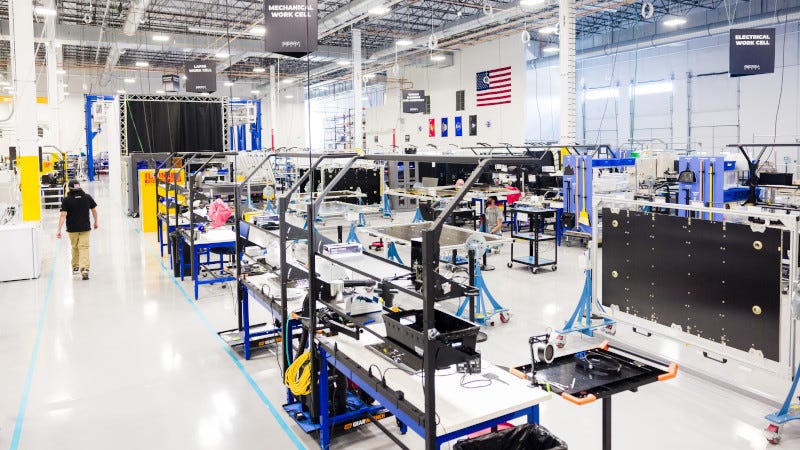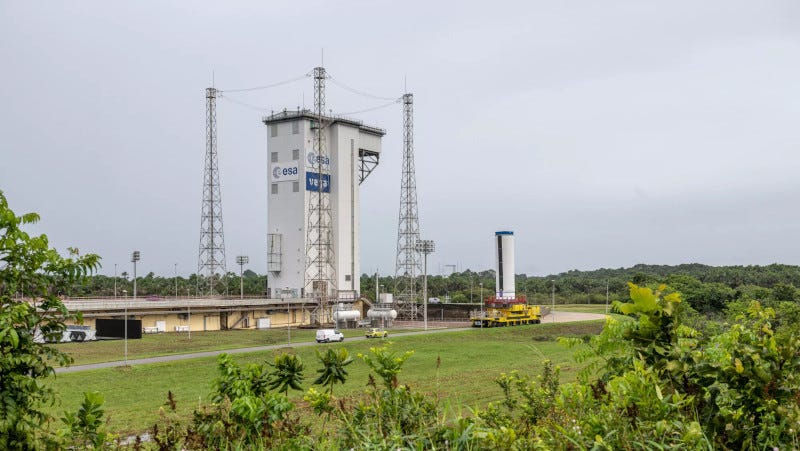The 68th Electron rocket was launched last weekend, deploying a single satellite to space for a confidential commercial customer. The mission was the second of two launches for Rocket Lab from the same launch site in less than 48 hours, a new launch record for the company.
The ‘Symphony In The Stars’ mission lifted-off from Rocket Lab Launch Complex 1 in Mahia, New Zealand on June 28th to deploy a single spacecraft to a circular Earth orbit. The mission was the first of two dedicated launches for the new customer on Electron booked less than four months ago, with a second mission scheduled before the end of 2025.
Rocket Lab has now completed four launches in June for commercial satellite constellation operators.
-0-
ESA has selected Rocket Lab to deploy the first pair of satellites for a future navigation constellation for Europe, LEO-PNT. The company will launch two Pathfinder A spacecraft for ESA, provided by European satellite prime contractors Thales Alenia Space and GMV, from Rocket Lab Launch Complex 1 no earlier than December 2025.
The spacecraft will be deployed to low Earth orbit as part of a mission to test a new approach of providing location, direction, and timing services from satellites in low orbit. The demonstration mission will assess how a low Earth orbit fleet of satellites can work in combination with the Galileo and EGNOS constellations in higher orbits that provide Europe’s own global navigation system.
-0-
But across the Tasman Sea in Australia, the Gilmour Space Eris Rocket remains on the ground waiting for its first test flight. In a statement posted on the company website, Gilmour Space said that they had made the "tough call to postpone this week’s launch. This pause to give us a longer, more flexible launch window for our first test flight, and our team a chance to rest after an intense few weeks of testing and prep."
The company said on Thursday that its new target launch date is now not earlier than Thursday, July 16th.
The launch has been on hold since May, when a payload fairing system malfunctioned on the launch pad, causing a fairing to dislodge from the spacecraft. The company says it has installed additional safeguards to prevent the malfunction from happening again.
-0-
Thanks for reading. You can support this newsletter and all of the content on The Journal of Space Commerce by becoming a paid subscriber. Whether you’re a space professional, investor or an enthusiast, paid subscribers have first access to premium articles and podcasts focused on the new space economy. Just visit www.exterrajsc.com on Substack, and help keep The Journal of Space Commerce independent as we chronicle, cajole and, when necessary, critique the commercial space industry.
-0-
A technology center expansion aimed at scaling up the production and delivery of Surface Mount Technology (SMT) solar power systems, including production for national defense applications, has been announced by Sierra Space.
Located in Broomfield, Colorado, Sierra Space’s Power Station is a new production facility that will house world-class manufacturing capabilities to produce Surface Mount Technology (SMT) defense-hardened solar arrays, which provide best-in-class power density, resiliency, and production lead times.
In addition to the SMT production lines, the $45 million facility also houses new tooling and an integrated test center that includes thermal vacuum/thermal air chambers, and a dynamics lab for vibration and pyroshock testing. These solar arrays have diverse applications, including for use on satellites. Solar power is critical for space missions as it provides a reliable, renewable energy source to support long-duration operations in orbit and beyond.
-0-
A Technology Safeguards Agreement (TSA) was signed between Sweden and the United States on June 20, moving Swedish Space Corporation (SSC) and Firefly Aerospace closer to a historic first satellite launch from Esrange Space Center in Kiruna, Sweden.
The bilateral agreement, signed at the Embassy of Sweden in Washington D.C., provides the legal and technical framework for U.S. commercial launches from Swedish spaceports while ensuring proper handling of sensitive technology. This agreement – only the sixth TSA signed by the United States with another country – allows SSC and Firefly Aerospace to continue building a comprehensive satellite launch service at Esrange Space Center and meet the increasing demand for orbital launch capabilities from mainland Europe.
Infrastructure development at SSC’s Esrange Space Center is progressing for Launch Complex 3C where Firefly’s Alpha rocket will launch. The tracking and control systems, security and depot facilities, and the Launch Control Center have already been established.
-0-
A first-of-its-kind persistent monitoring solution that delivers strategic operational and threat intelligence at global scale for a real-time decision advantage has been launched by Maxar Intelligence. Sentry integrates AI-powered capabilities unique to Maxar—including multi-source constellation orchestration, geospatial fusion, and advanced machine learning models for automated analytics—to deliver a new level of closed-loop spatial intelligence.
The suite is specifically designed to monitor hundreds of areas around the world to solve complex problems such as anticipating adversarial threats or protecting industrial infrastructure, and includes two products designed for specific mission sets:
Site Sentry, a product for monitoring places of interest across land and sea, such as shipyards, airports, urban centers and more. Maritime Sentry, a broad-area monitoring product for tracking vessel activity at sea and in port, enabling customers to actively monitor thousands of sq km of ocean at once.
Both Sentry products draw on Maxar’s 250+ petabyte archive of very high-resolution satellite imagery collected over more than two decades. This geospatial foundation provides training data for advanced AI/ML computer vision models that contain a detailed understanding of historical activity and global patterns across the world.
-0-
The four Airbus CO3D satellites and the CNES’s MicroCarb satellite will be launched into orbit on July 25 by Arianespace aboard a Vega C rocket. The VV27 launch is planned from Europe’s Spaceport in French Guiana.
The main passengers, the satellites that will make up the CO3D constellation, as well as the auxiliary passenger, MicroCarb, will be placed in Sun-synchronous orbits.
The CO3D (Constellation Optique 3D) satellites will deliver a global high-resolution Digital Surface Model (DSM) service to CNES providing 50 cm stereo imagery as well as 2D imagery for government and commercial customers. The data from the four dual-use satellites will feed a cloud-based ground segment operated by Airbus, including an image processing chain delivered by CNES. This data will answer both the military need for precise and up-to-date cartography as well as civil applications such as hydrology, geology, civil security, urban planning and land and resource management.
The CNES’ MicroCarb mission is designed to map sources and sinks of carbon dioxide (CO₂) using a dispersive spectrometer instrument that will measure atmospheric concentration of CO₂ with a high degree of precision.
-0-
And those are some of the top stories we covered for you on The Journal of Space Commerce this week. Space Commerce Week is a production of Ex Terra Media. You can get daily updates on space commerce by subscribing to The Journal of Space Commerce on Substack at www.exterrajsc.com. And please consider becoming a paid subscriber. Whether you’re a space professional, investor or an enthusiast, paid subscribers have first access to premium articles and podcasts focused on the new space economy. Just visit www.exterrajsc.com and help keep The Journal of Space Commerce independent as we chronicle, cajole and, when necessary, critique the commercial space industry.
I'm Tom Patton
Theme Stock Music provided by CoolTones, from Pond5




















